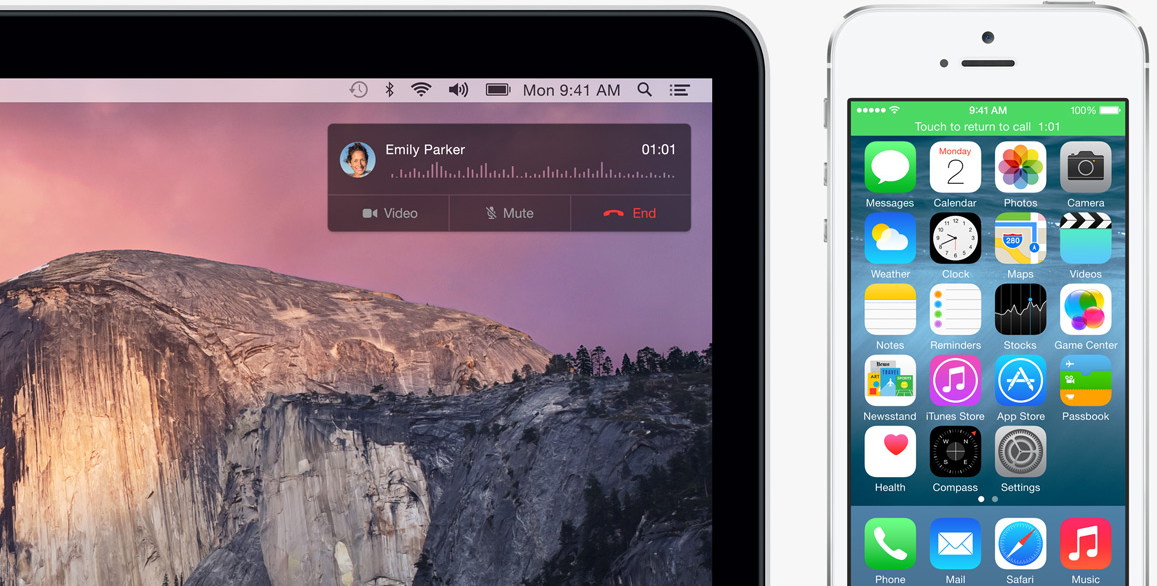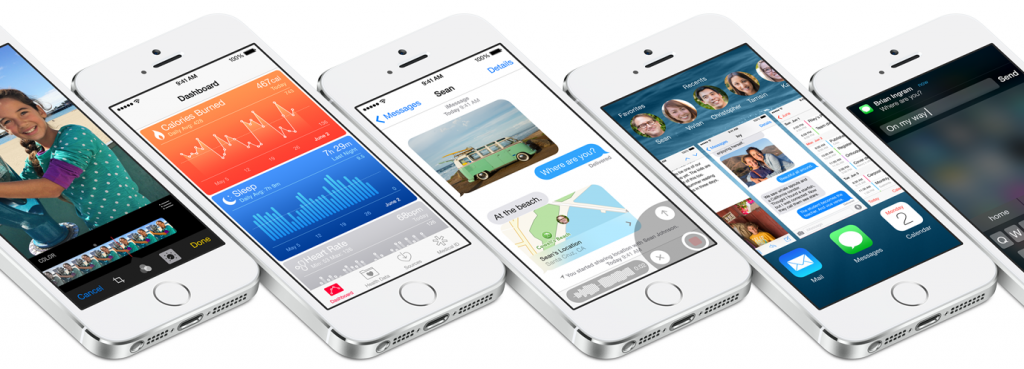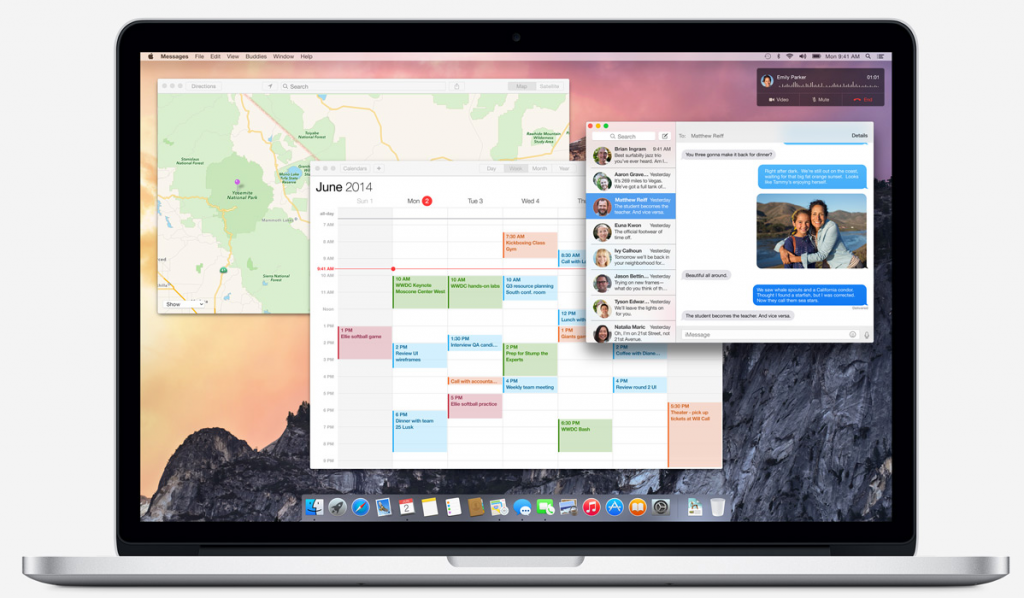
On Monday Apple held their annual World Wide Developers Conference in San Francisco introducing to the world the next versions of its mobile and desktop operating systems. Jump after the break for glimpses at iOS 8 and OS X Yosemite.

On the surface, iOS 8 doesn’t look all that much different from the iPhone & iPod touch’s current OS. But it most certainly packs a slew of new features and enhancements. Some of the most exciting new features lies in the Messages app. In iOS 8 you can send voice messages, along with texts, pictures, and video. Tap the new microphone button to record and send a voice message. When you are on the receiving end of a voice message, you can press the on-screen play button or simply raise the device to your ear to hear it. Apple’s also making it easier to share video almost when it’s happening; hit the camera button, record what’s happening around you, and text it immediately to your contacts of choice. It’s the closest you’ll get to sharing what’s going on around you without firing up FaceTime. And in light of SnapChat’s recent surge in popularity, Apple is making it possible to send self-destructive messages that disappear after a determined amount of time. Elsewhere, group messaging is getting so much better; you can control a group by removing people from it whenever you like, you can quiet the conversation on your end by flipping on a “do not disturb” sign, you can organize a group chat by giving it a title, and yes, you can leave the group whenever you like at the tap of a button labeled “leave this conversation.”
The perfect segue from talking about the Messages app is talking about iOS’ new keyboard, Quicktype. Apple’s calling it their “smartest keyboard ever” as it can learn your typing preferences over time and intelligently predict what you’ll likely type next. As you type you’ll notice a bar that hangs over the keyboard with words the OS thinks you’ll say next; if you see the word you’re thinking simply tap it instead of typing it out to save some precious seconds. In addition to providing words, the new keyboard also learns your speech style; for example, it will know when you’re typing a text to a friend or penning an email to a boss and the words it predicts will be tailored accordingly. Also of note, iOS 8 is the first version of iOS to finally support third-party keyboards system-wide; fans of Android’s Swype keyboard are assuredly happy to hear this.
Apple’s taking a page out of the jailbreak community’s playbook and allowing interactive notifications in iOS 8. This simply means that you can now respond to app notifications without being forced to leave the current app you’re in. For example, if you’re viewing pictures in your camera roll and a text message comes in, you can reply to that message without jumping out of the camera roll and into Messages. This applies to third-party apps too; when someone comments on your status update on Facebook you can interact with that notification by liking the comment or adding your own without having to jump out of your current experience and into Facebook. A slight design change was also made to the multitasking interface. Double tap the home button to see a carousel of all your open apps; what’s new to this section lies above the open apps–faces of people you’ve recently talked to and faces of your favorite contacts. Tap a head/name to quickly call, text, or initiate a FaceTime conversation with them.
The Camera app has been updated as well. With iCloud Photo Library all of your photos and videos live in the cloud and are instantly and automatically shared across all of your iCloud-enabled Apple devices. Take a picture on your iPhone and it will automagically blast to your iMac and MacBook. Libraries are searchable now; you can search for specific photos by date, time, location, and album name. New tools have been added to edit photos, too. You can now straighten horizons, crop, and precisely adjust light and color. When it comes to making photos pop with filters, you can use ones provided by Apple and now you can even manipulate photos with third-party app filter collections without leaving the Photos app. This is a part of Apple’s initiative to make iOS more of an open platform by allowing developers access to some of the OS’ core applications. And last, joining Panorama is a new camera mode: Time-lapse videos; set a designated recording time and the camera will capture awesome experiences like the sun-setting.
A brand new Apple designed app called Health will be released alongside iOS 8. It works in tandem with your collection of health and fitness apps to collate all of your relevant data in a single, easy-to-browse space. Data about your heart rate, calories burned, blood sugar, and cholesterol will be located in the Health app. Additionally, the developer-focused HealthKit will allow outside partners–with your discretion–access to your health data. Imagine easily sharing your blood pressure data with a doctor, or sharing your daily calorie count with a nutritionist. The possibilities are quite remarkable.
This is just the tip of the iceberg. Siri’s made smarter with song identification via Shazam integration and the ability to wake her up with a “Hey, Siri;” Spotlight’s been enhanced to search beyond your device to find what you’re looking for, now taking into consideration context and location; with Family Sharing up to six people can share purchases from iTunes, iBooks, and the App Store as well as photos across their respective devices; with iCloud Drive you can share and edit files across all your enabled Apple devices; and with Apple’s renewed focus on continuity you can even send text messages and place calls from your Mac. Which brings us to the next topic of discussion…

The next version of Apple’s desktop OS is OS X Yosemite and it too packs a quite the punch. You’ll notice right off the bat a cleaner take on the user interface: translucent, streamlined toolbars, and a more consistent and simplified experience from a fresh new look for the Dock and app icons to a new system-wide typeface. Search using Spotlight has been upgraded as well. Click that magnifying glass and in Yosemite a window will appear front and center; type query and the new Spotlight will search your files as well as outside sources like Wikipedia and the iTunes and App Stores to try and find what you’re looking for. A major enhancement to Notification Center lies in the new Today tab; here you’ll see a summary of the day’s upcoming events, reminders, and birthdays. You can also glance at customizable Widgets from apps like Calendar, Weather, Stocks, World Clock, Calculator, and Reminders. Apps like Safari (tab organization), Mail (attachment markup), Finder (iCloud integration), and Messages (see below) have been updated too.
Mentioned earlier was Apple’s renewed focus on continuity across all their iDevices. It all starts here: an iPhone running iOS 8 and a Mac powered by OS X Yosemite can recognize when they’re near each other as long as they are both connected to the same WiFi network and they are both signed into the same iCloud account. Once those stars align, you can do things like take phone calls on your Mac as well as send and receive text, photo, and audio messages on your desktop or laptop. With calls, your Mac essentially serves as speakerphone and you’ll be alerted to incoming calls if you’re iPhone is nearby. This feature will come in handy if, say, you are working on a report in your office and left your phone behind in the living room; a buddy calls and your computer will ring and you can choose to answer or decline the call. See a number in Safari or Contacts or Calendar? Tap it to initiate a call. There’s no additional set up necessary; same WiFi network, same iCloud account, boom. The Messages app in OS X has been made a lot more functional now that it can receive SMS and MMS text messages from any phone, not just iMessages from iDevices. In other words, now you can truly text message with your friends on your Mac. Also, automatically all of your text conversations on your phone will port over to your computer so you can easily pick up where you left off no matter the device you’re using.
Another perfect segue! A new OS X feature dubbed Handoff allows you to easily pass along whatever you might be working on your Mac right to your mobile iDevice. Working on an intensive spreadsheet in Numbers on your Mac and need to make last minute changes on-the-go? Use Handoff to automagically send the document to your iPad and continue your work right where you left off. Apple says the new feature works with Mail, Safari, Pages, Numbers, Keynote, Maps, Messages, Reminders, Calendar, and Contacts and devs can build it into their apps too.
Both iOS 8 and OS X Yosemite release this fall free of charge. Watch the WWDC keynote here.
So here’s the problem inherent to Apple in general: all these wonderful apps that enable continuity and sharing require an iCloud account. Apple magnanimously gives each user a puniferous 5 GB account. After that, you have to pay through the nose. Typical Apple. To make this magic work, you have to keep paying and paying and paying.
I am impressed that you recognized the jailbreak community for introducing one item in your review. Actually, most of the improvements are because of the diligent work of the jailbreak community. That counts not only for iOS 8, but all improvements previous as well.